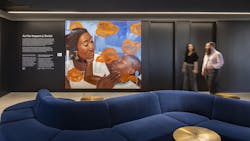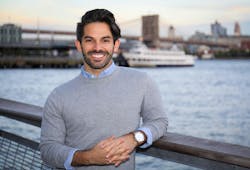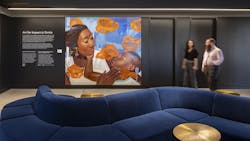What makes your business unique? One of the differentiators is prioritizing the S in ESG.
ESG stands for environmental, social, and governance. IBM defines ESG as the standards used to determine an organization’s environmental and social impact through investments, customers, suppliers, employees and the public. The social component assesses a company’s impact on the people, culture and surrounding communities. It measures the social impact of diversity, inclusivity, human rights, and supply chains.
Zach Flora, executive vice president of market growth at Fitwel, describes S as the side stage door at a theater that doesn’t garner as much attention as E and is harder to define. Frameworks like GRESB successfully monitor ESG in real estate, but it can be hard to identify core metrics.
“One thing we know is true that we see across all of Fitwel’s users … is that they are all tying health and wellbeing to that S concept,” Flora said. “The health and wellbeing of our employees [and] our ability to engage stakeholders in our community are important for us.”
While not inclusive of all aspects of ESG’s social, Fitwel helps clients define S from a health and wellbeing perspective and offers a framework to measure, invest and report on it.
Chely Wright, chief inclusion officer at Unispace, says they have developed a strategy around Unispace’s ability to tell a story as an end-to-end firm specializing in the strategy, design and construction of people-centric spaces. They metabolized that information to launch Unispace’s Art for Impact (AFI) program, which matches clients with nonprofit groups and community artists to bring their inclusivity goals to life in the workplace. One notable initiative was connecting Orrick, a global law firm, with LA-based artist Robert Vargas to highlight the mission of the nonprofit A New Way of Life in Orrick’s Los Angeles space. Unispace also partnered with the NGO Casa Congo and the Nicaraguan women’s collective Las Tejedoras to transform 50,000 ocean plastic bags into office art for clients. AFI uses art and community engagement to communicate that everyone is welcome in the workplace and create a more inclusive and engaging culture.
Wright shared how predictions about the coming together of ESG and Diversity, Equity, Inclusivity, and Belonging (DEIB) are occurring.
“I think there’s a lot of shared space there and it’s exciting to talk about elevating ESG as a practice and as a principle. I feel like DEIB is so politically charged now,” Wright said. “I feel DEIB is not as fit for purpose—future forward—as ESG is. I think people know it and know it is a force for good, but they don’t quite know how to bring it to life.”
Prioritizing the Social Component
Kickstarted from the COVID-19 pandemic, society saw a shift toward remote work, something that remains present today. For Wright, the mentality of working in an office is shifting, which challenges businesses interested in implementing ESG to impact beyond the four walls of the built environment.
“When we think about ESG and how it can and should be impacting workforces, I think we should talk about impacting beyond the four walls of a company’s built environment.”
Sara Karerat, managing director at the Center for Active Design—a nonprofit arm of Fitwel, noted the overlap between the environment and social components of ESG.
“I think of S as an opportunity to strengthen the E as well,” Karerat said. “When we think about every building having a landscaping budget, how can we think about this in a tangible way to have the broadest co-benefits? If we prioritize maintenance and tree canopies, those are two strongly proven approaches to improve mental health for a restorative environment and lower the temperature in the surrounding environment.”
Prioritizing the S should assess the culture and what matters to existing talent and potential talent. Wright urges organizations serious about attracting and retaining talent to lean into the S. So how do you do that?
- Find a way to organize a human resources/executive team to ask questions and be willing to use that information and take action on it.
- As an organization, do not be an “Askhole”—if you ask questions about doing good, be prepared to act on what you learn.
- Take meaningful action.
Once a company decides to focus on the S, it needs to ask questions to understand the values of employees and clients. Sometimes companies declare their ethos, but may not collectively reflect it, Wright said. Unispace offers two paid volunteer days—one personal and one team—to encourage people to give back. That shared experience and value proposition creates a team value and culture for the organization.
Employee Resource Groups (ERGs) are farm teams that provide access to leadership opportunities where those opportunities are not otherwise available. ERGs empower people to leadership roles who can showcase their organizational acumen and garner attention from leadership for future promotions.
Owners and managers can collaborate with stakeholders to optimize tenants’ experiences by incorporating design elements to boost the user experience. Fitwel’s framework identifies interventions and strategies to prioritize based on specified goals, which owners can leverage to link intervention strategies with value creation.
“Building managers are meant to engage with tenants of their buildings and are widely integrated into their lives and experiences,” Flora said. “They gravitate toward certain strategies like incorporating tree canopy, or adding landscaping or biophilic design because it’s something tangible employees and residents engage with daily.”
Leadership should also ensure a work-life balance when prioritizing the S. The American Psychological Association’s 2023 Work in America Survey found that remote workers reported having enough flexibility at work to maintain a work-life balance more often (75%) than hybrid (67%) or in-person workers (66%). Assessing demographics, people aged 18-25 are more likely to feel a lack of work-life balance compared to older generations. Forty-one percent of that demographic expressed concern in contrast to 26% of workers aged 44-57, 28% of workers aged 58-64 and 24% of workers aged 65 and older.
“If we’re not seeing the whole human that comes to work—for the eight hours that they’re clocked in—it’s a missed opportunity,” Wright said. “It could lead to losses due to elevated attrition.”
Wright added companies should quantify work-life balance, track, measure and report on it to determine the monetary savings in lost time and productivity.
Organizations that understand their power, position and resources can effectively maximize the S in ESG to separate them from competitors. But they must take steps to understand their team and clients beyond the workday.
About the Author
Lauren Brant
Buildings Editor
Lauren Brant is the editor of Buildings. She is an award-winning editor and reporter whose work appeared in daily and weekly newspapers. She strives to create content that is informative and actionable for professionals, helping them discover new products, technology, and insights to make smarter building decisions. In 2020, the weekly newspaper won the Rhoades Family Weekly Print Sweepstakes—the division winner across the state's weekly newspapers. Lauren was also awarded the top feature photo across Class A papers. She holds a B.A. in journalism and media communications from Colorado State University-Fort Collins and a M.S. in organizational management from Chadron State College.
Sign up for our eNewsletters
Get the latest news and updates






